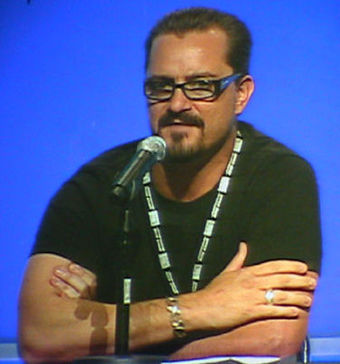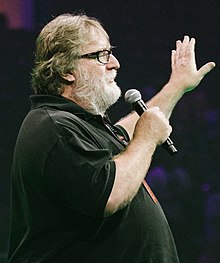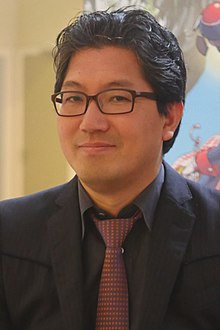Portal:Video games
The Video Games Portal

A video game, also known as a computer game or just a game, is an electronic game that involves interaction with a user interface or input device (such as a joystick, controller, keyboard, or motion sensing device) to generate visual feedback from a display device, most commonly shown in a video format on a television set, computer monitor, flat-panel display or touchscreen on handheld devices, or a virtual reality headset. Most modern video games are audiovisual, with audio complement delivered through speakers or headphones, and sometimes also with other types of sensory feedback (e.g., haptic technology that provides tactile sensations). Some video games also allow microphone and webcam inputs for in-game chatting and livestreaming.
Video games are typically categorized according to their hardware platform, which traditionally includes arcade video games, console games, and computer (PC) games; the latter also encompasses LAN games, online games, and browser games. More recently, the video game industry has expanded onto mobile gaming through mobile devices (such as smartphones and tablet computers), virtual and augmented reality systems, and remote cloud gaming. Video games are also classified into a wide range of genres based on their style of gameplay and target audience. (Full article...)
Featured articles –
Kingdom Hearts is a crossover of various Disney properties based in an original fictional universe. The series centers on the main character, Sora, and his journey and experiences with various Disney characters, as well as some from Square Enix properties, such as Final Fantasy, The World Ends with You, and Einhänder, in addition to original characters and locations created specifically for the series.
The series consists of thirteen games available for multiple platforms, and future games are planned. Most of the games in the series have been positively received and commercially successful. As of March 2022, the Kingdom Hearts series has shipped more than 36 million copies worldwide. A wide variety of related merchandise has been released along with the games, including soundtracks, action figures, companion books, light novels, a collectible card game, and a manga series. (Full article...)
The game world is navigated on foot and by vehicle, from either a third-person or first-person perspective. Players control the protagonists throughout single-player and switch among them, both during and outside missions. The story is centred on the heist sequences, and many missions involve shooting and driving gameplay. A "wanted" system governs the aggression of law enforcement response to players who commit crimes. In Grand Theft Auto Online, the game's online multiplayer mode, up to 30 players engage in a variety of different cooperative and competitive game modes.
Shared between many of Rockstar's studios worldwide, the game's development began around the time of Grand Theft Auto IV's release. The developers drew influence from many of their previous projects (such as Red Dead Redemption and Max Payne 3) and designed the game around three lead protagonists to innovate on the core structure of its predecessors. Much of the development work constituted the open world's creation, and several team members conducted field research around California to capture footage for the design team. The game's soundtrack features an original score composed by a team of producers who collaborated over several years. Grand Theft Auto V was released in September 2013 for the PlayStation 3 and Xbox 360, in November 2014 for the PlayStation 4 and Xbox One, in April 2015 for Windows, and in March 2022 for the PlayStation 5 and Xbox Series X/S. (Full article...)
The game was Rare's first game for the Nintendo 64. Its development team ranged between four and seven members, many of whom were recent graduates. The team sought to find gameplay to fit Rare co-founder Chris Stamper's idea for a building destruction game. The puzzle game mechanics were inspired by those of Donkey Kong (1994).
Blast Corps was released to critical acclaim and received Metacritic's second highest Nintendo 64 game ratings of 1997. The game sold one million copies—lower than the team's expectations—and received several editor's choice awards. Reviewers praised its originality, variety, and graphics, but some criticized its controls and repetition. Reviewers of Rare's 2015 Rare Replay retrospective compilation noted Blast Corps as a standout title. (Full article...)
This beneficial effect resulted in the glitch's coverage by strategy guides and game magazines, while game publisher Nintendo warned that encountering the glitch may corrupt players' game data. IGN noted MissingNo.'s appearance in Pokémon Red and Blue was one of the most famous video game glitches and commented on its role in increasing the series' popularity. Fans have attempted to rationalize and incorporate MissingNo. as part of the games' canon as an actual in-game character, and sociologists have studied its impact on both players and gaming culture as a whole. Additionally, references to the glitch and the circumstances around it have also appeared in other games, such as Vampire Survivors and The Binding of Isaac. (Full article...)

Age of Empires is a series of historical real-time strategy video games, originally developed by Ensemble Studios and published by Xbox Game Studios. The first game was Age of Empires, released in 1997. Nine total games within the series have been released so far as of October 28, 2021.
Age of Empires focused on events in Europe, Africa and Asia, spanning from the Stone Age to the Iron Age; the expansion game explored the formation and expansion of the Roman Empire. The sequel, Age of Empires II: The Age of Kings, was set in the Middle Ages, while its expansion focused partially on the Spanish conquest of the Aztec Empire. The subsequent three games of Age of Empires III explored the early modern period, when Europe was colonizing the Americas and several Asian nations were on the decline. Another installment, Age of Empires Online, takes a different approach as a free-to-play online game utilizing Games for Windows Live. A spin-off game, Age of Mythology, was set in the same period as the original Age of Empires, but focused on mythological elements of Greek, Egyptian, and Norse mythology. The fourth main installment in the series, Age of Empires IV, was released on October 28, 2021, also focusing on the Middle Ages.
The Age of Empires series has been a commercial success, selling over 25 million copies. Critics have credited part of the success of the series to its historical theme and fair play; the artificial intelligence (AI) players have fewer advantages than in many of the series' competitors. (Full article...)
F-Zero GX is the successor to F-Zero X and continues the series' difficult, high-speed racing style, retaining the basic gameplay and control system from the Nintendo 64 game. A heavy emphasis is placed on track memorization and reflexes. GX introduces a "story mode" element, where the player assumes the role of F-Zero pilot Captain Falcon through nine chapters while completing various missions.
The GX and AX project was the first significant video game collaboration between Nintendo and Sega. GX was well received by critics for its visuals, intense action, high sense of speed, and track design while its high difficulty has been criticized. In the years since its release it has been considered one of the GameCube's best titles, as well as one of the greatest video games ever made. (Full article...)
Development of Revelation lasted more than three years; Ubisoft had up to 80 employees working on the game. Musician Peter Gabriel lent his voice and a song to the game's audio; the original score was written by Exile's composer Jack Wall. Overall, reception to the game was positive; reviewers lauded the impressive visuals, sound, and puzzles. Publications such as Computer Gaming World took issue with the control scheme of the game. Revelation is the last game in the Myst series to use both prerendered backgrounds and full-motion video; the final game in the series, End of Ages, is rendered in real-time throughout. (Full article...)
Jill is the protagonist of several Resident Evil games, novelizations, films, and has also appeared in other game franchises including Marvel vs. Capcom, Project X Zone, Teppen, and Dead by Daylight. In later games, such as the 2002 Resident Evil remake, The Umbrella Chronicles (2007), Resident Evil 5 (2009), and The Mercenaries 3D (2011), her features were based on Canadian model and actress Julia Voth. Several actresses have portrayed Jill, including Sienna Guillory and Hannah John-Kamen in the live-action Resident Evil films.
Video game publications described Jill as among the most popular and iconic video game characters, and praised her as the most likable and consistent Resident Evil character. She has received both acclaim and criticism with regard to gender representation in video games. Several publications praised the series for its portrayal of women and considered Jill significantly less sexualized than other female game characters; she was also cited as an example of a female character who was as competent and skilled as her male counterparts. Others argued she was weakened as a protagonist by attributes that undermined her role as a heroine, specifically an unrealistic body shape that did not reflect her military background; some of her overtly sexualized costumes have also been criticized. (Full article...)
Did you know... -
- ... that fighting video game Panza Kick Boxing was endorsed by a French kickboxing champion who also supplied technical advice?
- ... that Paul Dini was a writer for both the animated television series Batman: The Animated Series and the video game series Batman: Arkham?
- ... that the video game Pyongyang Racer was developed in North Korea for Koryo Tours, which organises tours to the country?
- ... that development on the video game Expeditions: Rome was not affected by lockdowns from the COVID-19 pandemic because the developer was already split between Copenhagen and Istanbul?
- ... that the urban legend Herobrine was ranked on a Guinness World Records poll of the best video game villains, despite never existing?
- ... that for at least 90 minutes, Mori Calliope livestreamed herself begging video game developer Atlus to allow her to stream their game Persona 3?
- ... that deceased YouTuber Technoblade beat the video game Minecraft in hardcore mode using a racing-wheel controller?
- ... that the 1979 video game Superman was one of the first console games with a pause feature?
- ... that MicroProse was formed to publish Hellcat Ace after Sid Meier boasted that he could design a better video game than Red Baron in a week?
- ... that the 1999 video game Interplay Sports Baseball Edition 2000 used a public-address announcer while its rivals were switching to two commentators as featured on real MLB game broadcasts?
- ... that the name of the video game mod series Bomba Patch was inspired by éclairs?
- ... that Terra Invicta's development company is a group of former volunteer video game modders that decided to release their own game after the success of their mod?
Selected biography –
Selected image -

Recent video game-related events
- May 24, 2024 – Uvalde school shooting
- Families in Uvalde, Texas, U.S., file a lawsuit against Daniel Defense and Activision Blizzard for creating the DDM4 V7 gun and promoting the weapon through the game Call of Duty, respectively. They also sue Meta Platforms for owning Instagram, which was used by the gunman. (AP)
- April 16, 2024 – 2023–2024 video game industry layoffs
- American video game company Take-Two Interactive lays off 5% of its workforce. (Reuters)
- April 10, 2024 – 2023–2024 video game industry layoffs
- American video game company Epic Games announces that it will lay-off around 870 employees, roughly one-sixth of its workforce, due to slower growth than expected. (CBC via Yahoo! News)
Topics
Categories
Things you can do
In other Wikimedia projects
The following Wikimedia Foundation sister projects provide more on this subject:
-
Commons
Free media repository -
Wikibooks
Free textbooks and manuals -
Wikidata
Free knowledge base -
Wikinews
Free-content news -
Wikiquote
Collection of quotations -
Wikisource
Free-content library -
Wikiversity
Free learning tools -
Wiktionary
Dictionary and thesaurus













































